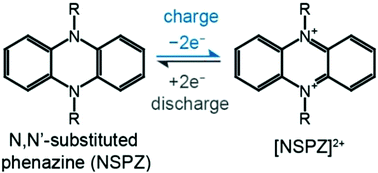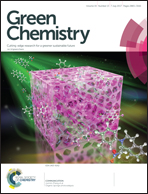Multi-electron redox phenazine for ready-to-charge organic batteries†
Abstract
Organic redox compounds represent an emerging class of cathode materials in rechargeable batteries for low-cost and sustainable energy storage. However, the low operating voltage (<3 V) and necessity of using lithium-containing anodes have significantly limited their practical applicability to battery systems. Here, we introduce a new class of p-type organic redox centers based on N,N′-substituted phenazine (NSPZ) to build ready-to-charge organic batteries. In the absence of lithium-containing anodes, NSPZ cathodes facilitate reversible two-electron transfer at 3.7 and 3.1 V accompanying anion association, which results in a specific energy of 622 Wh kg−1 in dual-ion batteries.

- This article is part of the themed collection: 2017 Green Chemistry Hot Articles


 Please wait while we load your content...
Please wait while we load your content...